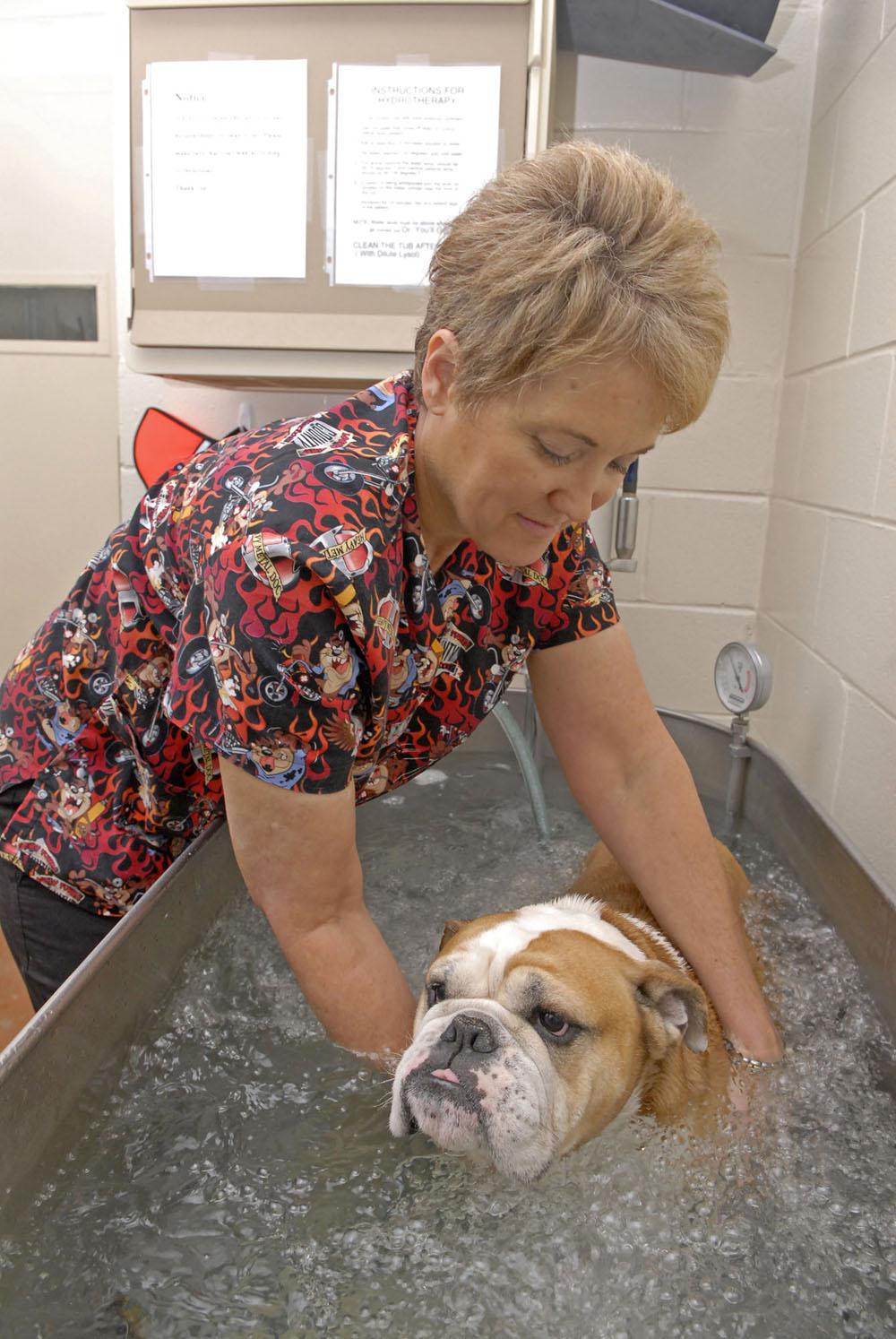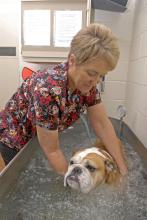Information Possibly Outdated
The information presented on this page was originally released on October 25, 2007. It may not be outdated, but please search our site for more current information. If you plan to quote or reference this information in a publication, please check with the Extension specialist or author before proceeding.
Life as MSU mascot suits Bully to a 'T'
By Patti Drapala
MSU Ag Communications
MISSISSIPPI STATE -- His auspicious debut at a 1935 football game between Mississippi State and Alabama brought the Bulldogs good luck and a 20-7 victory.
More than 72 years later, the university's canine mascot has become an icon. Because people instantly see Bully as the face of MSU, he must look good, feel great and behave properly to create a favorable impression. He succeeds as a goodwill ambassador because of the College of Veterinary Medicine's comprehensive approach to overseeing his health care and daily routine.
Six-year-old Bully is the 19th English bulldog to assume the role of official mascot. Born in Waynesboro, he is a descendant of Bully XVI and Bully XVII and registered by the American Kennel Club as “Mississippi's TaTonka Gold.” Unlike his predecessors, Bully is the first bulldog mascot owned by the university and trained into the role from the time he was 8 weeks old.
“We made an effort to put this cute, little, rambunctious puppy we had found after an 18-month search through some of the experiences he would have as an adult working dog,” said Dr. Margaret Kern, Bully's primary care veterinarian. “We took him to band and football practice, we walked him on the turf at Scott Field, and we took him to university functions to get him used to being around people.”
Veterinary technician Lisa Chrestman was assigned the role of trainer, guardian and scheduler for Bully. She quickly became his “mama.” Chrestman and her family (husband Al, son Austin, 15, and daughter Laura Grace, 9) have raised the mascot as a family pet at their home in Mathiston. He still resides there, along with two other dogs and three cats.
“My children think living with Bully is just awesome,” Chrestman said. “At home, he loves to roll in the dirt and then shake off a huge cloud of dust.”
Bully, who is affectionately nicknamed “T” by his family and CVM associates, rides to work with Chrestman and leaves with her when the day is done. He eats an evening meal of nutritionally balanced dog food and enjoys doggie treats, but he is not allowed to have people food except for stray popcorn on the floor of Humphrey Coliseum at basketball games.
“Everything we do with Bully is based on the principle that his health and well-being come first,” Chrestman said.
Chrestman remains at Bully's side for all public appearances, which include football games, all home basketball games and several spring baseball games at home while the weather is tolerable.
“Bully knows exactly when it's game day,” Chrestman said. “When he sees us get out the traditional MSU leather harness, he automatically goes into work mode.”
Because of their airway anatomy, many bulldogs are stressed by a combination of heat, humidity and overexertion, Kern said. The stress from those situations can cause respiratory difficulties. Some bulldogs are also prone to arthritis and other joint problems. Their body structure limits the amount of strenuous physical activity they can endure.
“We examine Bully the day before and the day of all public appearances to make sure he is capable of enduring the physical performance that is required of him,” Kern said. “I look closely for signs of breathing difficulty, particularly during and after exercise.”
Bully is a healthy, happy dog who exudes personality and exemplifies the standard of the breed. He weighs about 55 pounds, and his red-fawn and white coat is soft and thick. His confident nature allows him to remain unfazed by the excitement of sporting events and meeting strangers.
Elementary and secondary school students in Mississippi and neighboring states clamor for Bully's attention.
“The schoolchildren get excited when they hear ‘Who Let the Dogs Out?' because they know Bully's getting ready to appear,” Kern said.
Bully must maintain limber joints, a sleek physique and a consistent level of energy to enjoy the public adoration. Kern has prescribed a health maintenance program of massage therapy, exercise and whirlpool treatments that Bully undergoes three times a week for about an hour each session.
To begin his workout, Bully receives a muscle massage by canine physical therapist Ruby Lynn Carter-Smith. Carter-Smith uses the massage, which is a series of hand strokes from the head to the toes, to relax Bully and establish a bond between patient and therapist.
The massage also prepares his muscles for a short run on a treadmill to build up endurance.
“We start out at a slow speed,” Carter-Smith said. “Sometimes we will have a person in front of the treadmill, another behind it and me standing on the frame straddling him while he's walking to give him security and monitor his progress.”
Treadmill training is followed by several run-throughs on the cavaletti rails, a system of poles that are staggered in height, to flex his joints and muscles as he steps over them.
“We usually start out with the poles low to the ground and then raise them to give Bully's muscles a challenge,” she said.
Once the workout concludes, Bully heads to the whirlpool where he is immersed up to his neck for 15 minutes of hydrotherapy. The gentle bubbles ease the strain put on his joints and muscles during the exercise routine.
The whirlpool does not faze Bully. Because he receives a bath and grooming before every public appearance, Bully is comfortable in water, Chrestman said. She and other veterinary technicians check his eyes and clean the characteristic folds around his muzzle. He welcomes the attention because he knows he will get his tummy rubbed and his back scratched.
In addition to Bully's daily monitoring, he also gets comprehensive checkups by Kern every six weeks. She examines Bully's eyes, ears, teeth, gums, throat, skin, joints, coat and paws. She also supervises the administration of preventive medications and vaccinations.
“Bully has a little cowbell on his harness, and when he walks through the halls of the animal hospital, everyone knows he's coming,” Kern said. “This gives people enough time to quickly locate his treats.”
Kern is always on-call should Bully need medical assistance. During away trips and appearances, Chrestman carries an emergency bag with medications and equipment to assist in restoring normal breathing if Bully were to experience problems. She also has a doggie water bottle if he needs hydration.
At home games, Bully rides with Chrestman in a golf cart to his various appearances at FanFair and alumni functions before he arrives at Davis-Wade Stadium. The permanent doghouse built at the stadium for Bully has a concrete floor that contains copper pipes. Cool water is pumped through the pipes so that Bully will have a comfortable place to lie down should temperatures climb.
Is there anything Bully will refuse? Just one thing, according to Kern.
“He does not like to take medications in tablet form,” she said. “He can find pills when we hide them in a doggie treat or food. We have to be quick on the draw.”
Such is the life of this special dog.
Contact: Lisa Chrestman (662) 325-3638 or Dr. Margaret Kern (662) 325-3432




